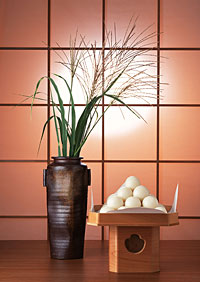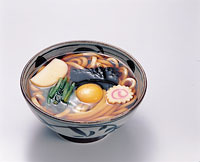Kids Web Japan
Web Japan > Kids Web Japan > Manga > September: Moon Watching
Manga
Sakura & Ichiro

Hashimoto Miki
Tell me more!

For centuries, the moon has held a mystical appeal for the Japanese, and it often appears in poetry. Tsukimi, or moon viewing, is a practice of appreciating the full moon in autumn that began over 1,000 years ago during the Heian period (794-1192).
Autumn, when the air is clear and outside temperatures are not too cold, is the perfect season for viewing the moon. The beautiful full moon that can be seen around this time is known as chushu no meigetsu. It occurs on the fifteenth night of the eighth month on the old lunar calendar, which in present-day terms is in September.
Around this time, people set up altars in places where they can see the moon. They decorate the altars with silver grass and place offerings like dumplings and sake. Then they quietly enjoy the sight of the brightly shining full moon.
The practice of moon viewing originally came from China. It has developed in its own way in Japan, where it is also celebrated on the thirteenth night of the ninth month on the lunar calendar.

(The Japan Forum)
Taketori Monogatari, Japan's oldest folktale, is the story of a princess who came from the moon; every Japanese child knows this charming tale. In Japan the markings on the moon are said to resemble a hare pounding rice cakes. And some Japanese foods that include eggs, such as udon (flour noodles) in hot soup topped with a raw egg, are known as tsukimi. All in all, the moon is a familiar part of children's lives in Japan.